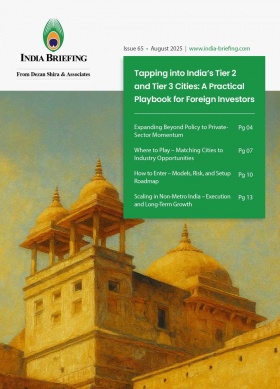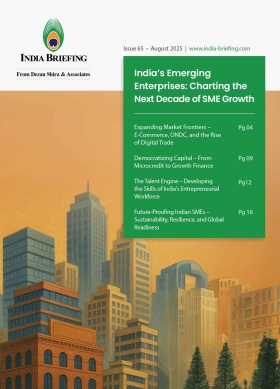India Proposes 100% FDI in Insurance: Market Entry Considerations
India hopes to permit 100 percent foreign direct investment (FDI) in its insurance sector under proposed 2025 amendments. If passed by parliament, the reforms will eliminate existing ownership caps and governance restrictions. The move is designed to attract long-term foreign capital, enhance competition, and accelerate growth in one of the world’s fastest-expanding insurance markets.
India is preparing to fully open its insurance sector to foreign capital. On August 29, 2025, the Union Ministry of Finance issued a notification proposing to raise the FDI limit in the insurance segment from 74 percent to 100 percent. The amendment, introduced under the Indian Insurance Companies (Foreign Investment) Amendment Rules, 2025, will allow foreign investors to establish wholly owned insurance subsidiaries (through the automatic route), subject to verification by the Insurance Regulatory and Development Authority of India (IRDAI).
According to media reports and market analysts, the move is intended to accelerate foreign investor participation, unlock new capital inflows, and capitalize on the sectoral growth. The move reflects India’s broader push to liberalize its financial services sector and position itself as a competitive global insurance hub.
Foreign investments in India’s insurance segment
India’s FDI regime in insurance has evolved steadily over the past two decades. The sector first opened to foreign investment in 2001 with a 26 percent cap, which rose to 49 percent in 2015 through legislative amendments. In 2021, the ceiling increased to 74 percent, subject to solvency and governance safeguards.
In the Union Budget 2025, the central government reaffirmed plans to allow 100 percent FDI for insurers that reinvest their entire premiums in India, promising to rationalize regulatory guardrails.
Proposed liberalization of FDI rules in insurance
India’s insurance sector is currently governed by the Indian Insurance Companies (Foreign Investment) Rules, 2015, which set conditions on foreign investment in both insurers and intermediaries. The existing framework allows up to 74 percent foreign ownership in insurance companies but imposes several governance requirements. A majority of directors and key managerial personnel must be resident Indian citizens, and at least one of the chairperson, managing director (MD), or chief executive officer (CEO) must be a resident Indian. Companies with over 49 percent foreign equity are further required to maintain a specific board composition and retain half of their net profits in reserves if their solvency margin falls below 1.8 times.
Insurance intermediaries are also subject to restrictions, including prior approval from the IRDAI for dividend repatriation, limits on payments to foreign affiliates, and compliance with board and management composition norms. Those with majority foreign ownership must file a Schedule AA Undertaking, which caps related-party payments and mandates that most directors and key managers be resident Indian citizens.
India has now proposed amendments to significantly ease these rules. The draft changes would remove most conditions on foreign ownership in insurance companies, retaining only the requirement that at least one of the chairperson, MD, or CEO must be a resident Indian citizen. For intermediaries, most existing obligations—including dividend repatriation approvals, board composition norms, and residency requirements—would be dropped, while retaining only the requirements to bring in advanced skills and disclose payments to group entities. The Schedule AA Undertaking and related intermediary regulations would also be revised accordingly.
Strategic considerations for investors
The proposed liberalization of India’s insurance FDI regime presents a rare inflection point for global insurers and intermediaries, offering the chance to establish full ownership and control in one of the world’s fastest-growing yet underpenetrated insurance markets. While this shift unlocks significant opportunities, it also calls for a measured and strategic approach to market entry and expansion.
Market entry structures and capital planning
With the removal of joint-venture requirements, foreign players could enter India either through greenfield subsidiaries or by acquiring majority stakes in existing insurers. This creates flexibility in structuring investments, deploying capital, and aligning ownership models with long-term growth plans. Investors should, however, assess capital allocation carefully given India’s stringent solvency norms, potential currency fluctuations, and the expectation that retained profits will be reinvested locally to support expansion and regulatory capital buffers.
Regulatory alignment and IRDAI engagement
Although the proposed rules significantly reduce entry barriers, IRDAI oversight remains central to market operations. Early and continuous engagement with the regulator will be essential for licensing, product approvals, solvency monitoring, and compliance systems. Investors will also need to prepare for a dynamic regulatory environment, as further legislative amendments to the Insurance Act, 1938 and FEMA (Non-Debt Instruments) Rules, 2019 will follow the FDI reforms.
Operational autonomy and localization strategy
Full ownership allows foreign insurers greater operational autonomy, enabling faster decision-making and integration with global systems. However, localization will remain vital for success—especially in product design, distribution, and customer engagement. India’s diverse socio-economic demographics, regional language preferences, and evolving risk profiles require tailored insurance products and multi-channel delivery models, including partnerships with local banks, fintechs, and digital aggregators. Building strong local talent pipelines will also be key, given the high reliance on distribution networks and customer trust in the sector.
Competitive positioning and brand differentiation
Foreign insurers entering with 100 percent ownership must position themselves clearly—whether through innovation, customer experience, or specialized risk coverage. Digitalization, embedded insurance models, and parametric products could be areas for differentiation. Strategic investments in health-tech or insure-tech ecosystems could also help capture underserved segments in Tier-II and Tier-III cities, where growth potential is strongest.
Long-term value and exit optionality
A liberalized FDI framework can improve exit optionality for investors, including future listings, strategic stake sales, or cross-border mergers. However, given India’s low penetration but high growth trajectory, investors should approach the market with a long-term value-creation lens. Building scale, brand equity, and trust in the market will take time and sustained investment, especially as insurance is a highly regulated and capital-intensive sector.
An overview of India’s insurance industry
India’s insurance industry has expanded rapidly over the past decade, driven by socio-economic progress, rising financial literacy, and a series of regulatory reforms aimed at strengthening market access. It spans life, health, and general insurance segments.
As of 2025, the sector includes 59 companies—comprising 25 life insurance companies and 34 general insurance firms. Yet, despite its size, the overall insurance market reach in India remains low at 4.2 percent of GDP, with life insurance contributing about 3 percent and general insurance around 1 percent. This is well below the global average of roughly 7 percent, highlighting significant headroom for growth.
Insurance industry’s growth potential
India’s insurance market has nevertheless shown strong momentum, recording a compound annual growth rate (CAGR) of nearly 14 percent over the past five years. In value terms, a market report estimates insurance industry value at US$303 billion in 2024 and projects it to reach US$808 billion by 2033, reflecting an expected annual growth rate of 11.5 percent.
Life insurance continues to dominate, accounting for nearly three-fourths of total premiums, while non-life segments—including health, motor, and crop insurance—are expanding steadily. In June 2025, life insurers reported new business premiums of INR 935.44 billion (US$10.6 billion), marking a 4.25 percent year-on-year increase, largely driven by a rise in single-premium policies. The non-life segment also posted strong gains, with gross direct premiums growing 6.5 percent year-on-year to INR 222.57 billion (US$2.52 billion) in May 2025, led by robust performance in standalone health insurance.
(US$1 = INR 88.09)
About Us
India Briefing is one of five regional publications under the Asia Briefing brand. It is supported by Dezan Shira & Associates, a pan-Asia, multi-disciplinary professional services firm that assists foreign investors throughout Asia, including through offices in Delhi, Mumbai, and Bengaluru in India. Dezan Shira & Associates also maintains offices or has alliance partners assisting foreign investors in China, Hong Kong SAR, Vietnam, Indonesia, Singapore, Malaysia, Mongolia, Dubai (UAE), Japan, South Korea, Nepal, The Philippines, Sri Lanka, Thailand, Italy, Germany, Bangladesh, Australia, United States, and United Kingdom and Ireland.
For a complimentary subscription to India Briefing’s content products, please click here. For support with establishing a business in India or for assistance in analyzing and entering markets, please contact the firm at india@dezshira.com or visit our website at www.dezshira.com.
- Previous Article India’s GST Overhaul: What Goods Become Cheaper and What Gets Costlier
- Next Article India to Remove GST Compensation Cess from Sept. 22, 2025: Details Here








